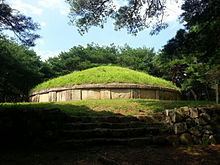Hangul 진덕여왕 Revised Romanization Jindeok Yeowang | Hanja 眞德女王 McCune–Reischauer Chindŏk Yŏwang | |
 | ||
Similar | ||
Queen Jindeok of Silla (? - 654), reigned as Queen of Silla, one of the Three Kingdoms of Korea, from 647 to 654. She was the kingdom's 28th ruler, and its second reigning queen following her predecessor Queen Seondeok. During her reign, Silla jockeyed with Baekje for favor in the Chinese Tang court. She is also known for writing a poem of the Emperor Gaozong of Tang.
Contents
Reign
Queen Jindeok (r.647-654) ascended the throne and became the Silla's second Queen regnant after Queen Seondeok. The last monarch from the ranks of the Seonggol, the highest class in the Silla's unique caste system, her real name is Seungman. Her father was Kim Gukban, who was King Jinpyeong's youngest brother, and her mother was Lady Wolmyeong. During her seven-year reign Queen Jindeok's primary concern was foreign policy. With the help of general Kim Yushin she was able to strengthen Silla's defenses and greatly improve her kingdom's relations with Tang China. Those efforts laid the foundation for the unification of the three kingdoms (Silla, Baekje, and Goguryeo).
She also expanded the Pumju tax-collecting system.
Her tomb is located on the hill in Gyeongju city. Although some historians have doubt that if it is really the tomb of Queen Jindeok. According to the Samguk Sagi she was buried at Saryangbu, which is located in the opposite direction from the tomb.
Legacy
When King Jeonggang was dying in 887, he appointed his sister Jinseong as his heir, justifying the choice of a female monarch by pointing at Seondeok's and Jindeok's successful reigns.
